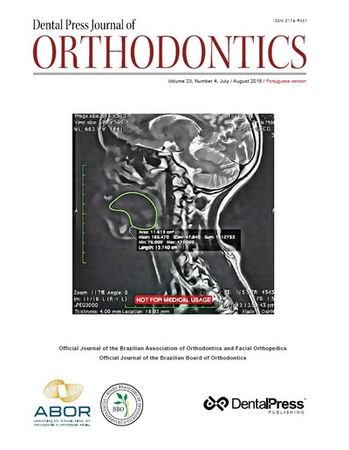Side effects of mandibular advancement splints for the treatment of snoring and obstructive sleep apnea: a systematic review
Artigo Original
Introduction: Occlusal side effects or development of pain and/or functional impairment of the temporomandibular complex are potential reasons for poor compliance or abandonment of mandibular advancement splints treatment for snoring and obstructive sleep apnea. Objective: This study aimed at providing a comprehensive review evaluating the craniofacial side effects of oral appliance therapy for snoring and obstructive sleep apnea. Methods: An electronic search was systematically conducted in PubMed and Virtual Health Library from their inception until October 2016. Only Randomized...
Autores: Cauby Maia Chaves Júnior, Cibele Dal-Fabbro, Lia Bittencourt, Rowdley Robert Pereira Rossi, Paulo Afonso Cunali, Olivia De Freitas Mendes Martins,







Objetivo: o presente estudo foi uma tentativa de investigar a relação volumétrica língua/mandíbula em crianças, usando imagens de ressonância magnética (IRM), para triagem inicial e como meio auxiliar no plano de tratamento.
Leia mais
The last decades have witnessed important and profound changes in communications. We exchanged long waits for desired telephone calls, to instant text messages via apps, where we can even acknowledge if the subject is online or not. The world becomes small, reachable at our fingertips by means of portable devices, and the information becomes horizontal, blurring social differences. This generates knowledge and at the same time the demand for services.
Leia mais
A frequent clinical situation when removing the fixed orthodontic appliance from our patients is the presence of gingival hyperplasia. The presence of orthodontic devices makes hygiene difficult, preventing correct plaque removal, which leads to inflammation and hyperplasia. Hyperplastic gingiva is sensitive to touch and probing, causing a lot of bleeding. Removing the appliance facilitates cleaning methods by reducing inflammation within a few days. However the time involved in this process...
Leia mais
To biologically explain why the orthodontic treatment does not induce pulp necrosis and calcific metamorphosis of the pulp, this paper presents explanations based on pulp physiology, microscopy and pathology, and especially the cell and tissue phenomena that characterize the induced tooth movement. The final reflections are as follows: 1) the orthodontic movement does not induce pulp necrosis or calcific metamorphosis of the pulp; 2) there is no literature or experimental and clinical models...
Leia mais
Introduction: It is recently suggested that titanium dioxide (TiO2) nanoparticles can be added to bracket luting agents in order to reduce bacterial activity and protect the enamel. However, it is not known if this addition can affect the shear bond strength (SBS) below clinically acceptable levels. Therefore, this study examined this matter within a comprehensive setup. Methods: This in vitro experimental study was conducted on 120 extracted human premolars randomly divided into four groups...
Leia mais
Introduction: Knowledge of the growth status of patients is essential to formulate and initiate a precise treatment plan. This study aimed at determining the role of calcification of permanent mandibular teeth for the assessment of skeletal maturity. Methods: A cross-sectional study was conducted using lateral cephalograms and dental panoramic radiographs of 360 patients (ages 7-18 years) equally divided into six groups according to cervical vertebral maturation stages. Skeletal age was...
Leia mais
Introduction: Occlusal side effects or development of pain and/or functional impairment of the temporomandibular complex are potential reasons for poor compliance or abandonment of mandibular advancement splints treatment for snoring and obstructive sleep apnea. Objective: This study aimed at providing a comprehensive review evaluating the craniofacial side effects of oral appliance therapy for snoring and obstructive sleep apnea. Methods: An electronic search was systematically conducted in...
Leia mais
Objective: The present article aims at reporting the clinical case of a patient who suffered trauma at two years of age, causing almost complete apical displacement of the deciduous maxillary left central incisor and of the permanent incisor. Methods: Ectopia secondary to intrusion was minimized by surgical removal of the ectopic tooth, and the left permanent canine was submitted to orthodontic traction to replace the extracted tooth. Results: The treatment period lasted 36 months, resulting...
Leia mais
Introduction: Research in Orthodontics has historically followed the positivist model based on the direct relationship of cause and effect between diseases and their specific etiological factors. Despite the objectivity and the great potential of statistical procedures, quantitative methods have progressively been sharing space with other models that can encompass the multiplicity of factors that affect the health-disease process, which until such time was reduced to its biological...
Leia mais
Objective: The present study was an attempt to investigate tongue/mandible volume ratio in children, using volumetric magnetic resonance imaging (MRI) for early screening and to aid in treatment planning. Methods: Volumetric evaluation of tongue volume/mandible volume ratio (TV/MV ratio) in children with obstructive sleep apnea (OSA) using MRI was carried out retrospectively on available DICOM MR images of children in the age group of 10-14 years. MRI image records of patients diagnosed with...
Leia mais
Hypodontia is the most prevalent craniofacial malformation in mankind. It may present a wide variety of manifestations and, depending on the number and location of missing teeth, it may affect the esthetics, mastication, speech and occlusal balance. This paper discusses the therapeutic approaches to solve this condition, describing a case report with hypodontia of one mandibular lateral incisor, which treatment option included space closure at the region of hypodontia associated with...
Leia mais
Objective: the present study aimed at evaluating the risks and vulnerability of orthodontists to legal compensation actionsand verifying the hypothesis of these health care professionals having little knowledge concerning their rights andobligations as service providers.Methods: Three groups were formed to participate in a semi-structured interview. The first group had thirteen lawprofessionals, the second group was composed of eleven orthodontists and the third group was made up of nine...
Leia maisCopyright © 1998 - 2022 DentalGO | Todos Direitos Reservados. DentalGO é uma marca Dental Press